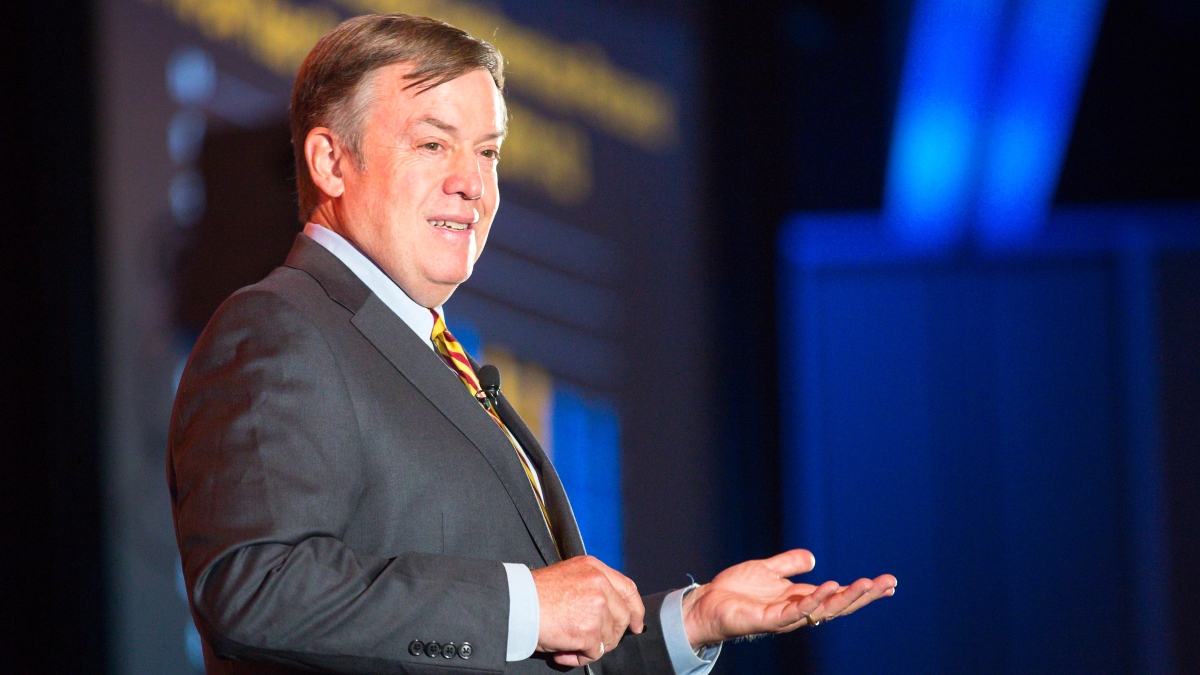Arizona's economic success tied to Hispanic education, Crow says

President Michael M. Crow addresses more than 1,000 people at the Arizona Hispanic Chamber of Commerce’s 19th annual “DATOS: The State of Arizona’s Hispanic Market,” held Sept. 23 at the Arizona Biltmore. The president spoke of the increasing need for Arizona Latino students to continue their education to improve both their and the state’s economy.
Photo by: Charlie Leight/ASU News
Arizona’s Hispanic population has nearly tripled since 1990 and accrued an estimated spending power of about $40.3 billion this year alone, but the state’s economy will not advance if education does not improve for this growing group, Arizona State University’s president told the annual DATOS conference Wednesday.
Michael M. Crow delivered the keynote address at the Arizona Biltmore in Phoenix to more than 1,000 Latino business and community leaders attending the Arizona Hispanic Chamber of Commerce’s 19th Annual “DATOS: The State of Arizona’s Hispanic Market.”
He hailed Hispanic Americans for having the highest aspiration of achieving the “American dream” among all ethnic groups. But nationally only 15 percent have graduated from college — considered a crucial determinant of upward mobility — and their incomes remain significantly below average.
“The one thing we need to focus our energy on is the educational attainment of all people, and in particular people of Latino descent,” Crow said. “Our economic success will depend on the realization of the American dream for all ethnic groups. If you have that aspiration energizing large parts of your population, there’s nothing you cannot achieve.”
Addressing the Hispanic education gap is not just about social justice, democracy or equal opportunity, but about Arizona’s “economic imperative,” he said. Compared with other states, Arizona is lagging and trending downward, now below the 80th percentile, in per capita gross domestic product relative to the U.S. average, while other states such as Texas, Colorado and Utah are climbing.
“We used to be historically at the national average or above it,” Crow said about Arizona’s GDP and low postsecondary-education enrollment rate, fifth lowest in the nation. “This is a function of one thing, educational attainment.”
A report by the Georgetown University Center on Education and the Workforce estimates that by 2020, 68 percent of all Arizona jobs will require postsecondary education. That estimate contemplates a 100 percent graduation rate from high school followed by more education and training, said Crow.
“University degrees, community college degrees, technical degrees, completion of high school, mean only one thing,” Crow said. “You’re better prepared for adaptation with them, than without them.”
Crow said more jobs are available to those with education because they have a higher ability to adapt more quickly, think flexibly, learn more quickly and move their lives forward.
“This new kind of world and economy is not where only a few people go to college or a handful of people are selected for some unique kind of training … and everyone else is just left being paid minimum wage and doing repetitive tasks,” Crow said. “The new economy requires a new kind of university.”
The ASU model, known as the New American University, is about enhancing local impact in the community, Crow said. It’s about becoming a global center for knowledge and discovery. But it’s ultimately about the students.
“Our goal is to produce a master learner from any family, from any background, from any income level, who can be a critical thinker,” said Crow, while emphasizing that nearly 40 percent of ASU students are the first in their families to attend college. “Our goal is to be accessible and fantastically successful academically.”
The DATOS conference report, presented during the event, has become a “comprehensive and reliable source of fact-based information about the state’s Hispanic market,” according to the Arizona Hispanic Chamber of Commerce. The report is meant to serve not just Arizona Hispanics but all public and private contributors to the state’s economic agenda.
Loui Olivas, ASU professor emeritus of business management, presented the report to the audience and provided some eye-opening facts about the impact of the nation’s Hispanic purchasing power — estimated to reach $1.5 trillion this year.
“$1.5 trillion is comparable to the GDP of Australia,” Olivas said. “The GDP is the total of all goods and services produced in a country in one year, and the Hispanic purchasing power in the U.S. has already surpassed Australia.”
This year’s report also revealed that from 2007 to 2012 the number of Hispanic-owned businesses grew 70 percent to 89,763, and census data presented by AZHCC revealed that nearly half of these firms — 41,843 — are owned by Hispanic women.
“We know that Latinas are succeeding here, we know that they’re making a difference,” said Monica Villalobos, AZHCC vice president. “Despite political differences, despite economic differences and despite cultural differences, they’re thriving in Arizona and that’s a story we need to tell the rest of the country.”

